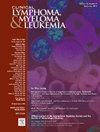Chemotherapy Trends in Acute Myeloid Leukemia: 2004 to 2020
IF 2.7
4区 医学
Q2 HEMATOLOGY
引用次数: 0
Abstract
Background
Chemotherapy is crucial for treating acute myeloid leukemia (AML), as it improves survival and quality of life. However, prior studies have shown that many eligible patients in the United States do not receive chemotherapy due to demographic and socioeconomic disparities.
Patients and Methods
We utilized the National Cancer Database to analyze chemotherapy utilization in 82,755 patients with AML from 2004 to 2020. We examined trends in 2 time periods, 2004 to 2010 and 2011 to 2019, with a separate analysis for 2020 to evaluate the impact of the COVID pandemic on chemotherapy use.
Results
Among all patients with AML, 57.1% received multiagent chemotherapy, 20.5% received single-agent chemotherapy, and 22.4% received no chemotherapy. Chemotherapy use rose from 72.9% in 2004 to 81.3% in 2019, then slightly declined to 80.6% in 2020. The odds of receiving chemotherapy increased significantly in 2011 to 2019 compared to 2004 to 2010 based on age (P = .02), race (P < .01), and AML subtype (P = .03). Patients aged 18 to 40 consistently had higher chemotherapy utilization rates, with treatment odds rising across all age groups. While Black patients were less likely than White patients to receive chemotherapy from 2004 to 2010, their odds improved significantly in 2011 to 2019. Despite increased chemotherapy use across all AML subtypes, therapy-related AML consistently showed the lowest odds of treatment. Lower-income patients, those with more co-morbidities, and female patients had reduced chances of receiving chemotherapy, and these inequities remained largely consistent over time.
Conclusion
This large database study highlights improved but persistent disparities based on demographic and socioeconomic status, calling for innovative measures to expand chemotherapy use.
急性髓性白血病的化疗趋势:2004 - 2020。
背景:化疗是治疗急性髓性白血病(AML)的关键,因为它可以提高生存率和生活质量。然而,先前的研究表明,由于人口统计学和社会经济差异,美国许多符合条件的患者没有接受化疗。患者和方法:我们利用国家癌症数据库分析2004年至2020年82755例AML患者的化疗使用情况。我们研究了2004年至2010年和2011年至2019年两个时间段的趋势,并对2020年进行了单独分析,以评估COVID大流行对化疗使用的影响。结果:在所有AML患者中,接受多药化疗的占57.1%,接受单药化疗的占20.5%,未接受化疗的占22.4%。化疗使用率从2004年的72.9%上升到2019年的81.3%,然后略有下降到2020年的80.6%。与2004 - 2010年相比,2011 - 2019年接受化疗的几率在年龄(P = 0.02)、种族(P < 0.01)和AML亚型(P = 0.03)的基础上显著增加。18至40岁的患者化疗使用率一直较高,所有年龄组的治疗成功率都在上升。虽然从2004年到2010年,黑人患者接受化疗的可能性低于白人患者,但在2011年至2019年,他们的几率显著提高。尽管所有AML亚型的化疗使用增加,但治疗相关的AML始终显示出最低的治疗几率。低收入患者、合并症较多的患者和女性患者接受化疗的机会减少,这些不平等在很大程度上保持一致。结论:这项大型数据库研究强调了基于人口和社会经济地位的改善但持续存在的差异,呼吁采取创新措施扩大化疗的使用。
本文章由计算机程序翻译,如有差异,请以英文原文为准。
求助全文
约1分钟内获得全文
求助全文
来源期刊

Clinical Lymphoma, Myeloma & Leukemia
ONCOLOGY-HEMATOLOGY
CiteScore
2.70
自引率
3.70%
发文量
1606
审稿时长
26 days
期刊介绍:
Clinical Lymphoma, Myeloma & Leukemia is a peer-reviewed monthly journal that publishes original articles describing various aspects of clinical and translational research of lymphoma, myeloma and leukemia. Clinical Lymphoma, Myeloma & Leukemia is devoted to articles on detection, diagnosis, prevention, and treatment of lymphoma, myeloma, leukemia and related disorders including macroglobulinemia, amyloidosis, and plasma-cell dyscrasias. The main emphasis is on recent scientific developments in all areas related to lymphoma, myeloma and leukemia. Specific areas of interest include clinical research and mechanistic approaches; drug sensitivity and resistance; gene and antisense therapy; pathology, markers, and prognostic indicators; chemoprevention strategies; multimodality therapy; and integration of various approaches.
 求助内容:
求助内容: 应助结果提醒方式:
应助结果提醒方式:


